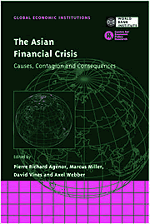Book contents
- Frontmatter
- Contents
- List of figures
- List of tables
- Preface
- List of conference participants
- Acknowledgements
- List of abbreviations and acronyms
- Introduction
- Part One General Accounts
- Part Two Theoretical Contributions
- 5 Capital markets and the instability of open economies
- Discussion
- 6 Volatility and the welfare costs of financial market integration
- Discussion
- 7 A theory of the onset of currency attacks
- Discussion
- Part Three Contagion
- Part Four Policy Responses
- Index
7 - A theory of the onset of currency attacks
from Part Two - Theoretical Contributions
Published online by Cambridge University Press: 26 February 2010
- Frontmatter
- Contents
- List of figures
- List of tables
- Preface
- List of conference participants
- Acknowledgements
- List of abbreviations and acronyms
- Introduction
- Part One General Accounts
- Part Two Theoretical Contributions
- 5 Capital markets and the instability of open economies
- Discussion
- 6 Volatility and the welfare costs of financial market integration
- Discussion
- 7 A theory of the onset of currency attacks
- Discussion
- Part Three Contagion
- Part Four Policy Responses
- Index
Summary
Introduction
The swiftness and devastating effect of recent financial crises pose considerable challenges for economists seeking an explanation of their onset. It is easy to give a narrative of the sequence of events leading up to the crisis with the benefit of hindsight. However this falls short of an explanation, since it begs the question of why the crisis occurred at that particular moment in time. More importantly, it does not explain the absence of a crisis in apparently similar countries, or in the same country at different moments in history. The challenge is all the more acute in the light of evidence that the onset of the Asian financial crisis of 1997 was largely unanticipated by market participants, as well as by the international agencies. Radelet and Sachs (1998) note that credit-risk spreads for borrowers in the region increased only after the crisis was in full swing, and the credit-rating agencies were largely reacting to events rather than acting in advance. Nor was there much indication from international agencies or the country analysts of normally canny investment banks that a crisis of such magnitude was brewing.
Given the difficulties in coming up with a rigorous theory, it is tempting to fall back on unexplained shifts of sentiment on the part of fickle investors, or the unexplained onset of panic among creditors as an explanation.
- Type
- Chapter
- Information
- The Asian Financial CrisisCauses, Contagion and Consequences, pp. 230 - 255Publisher: Cambridge University PressPrint publication year: 1999
- 22
- Cited by



